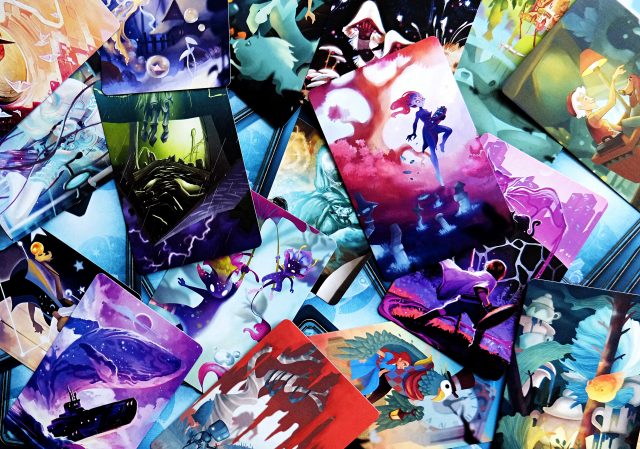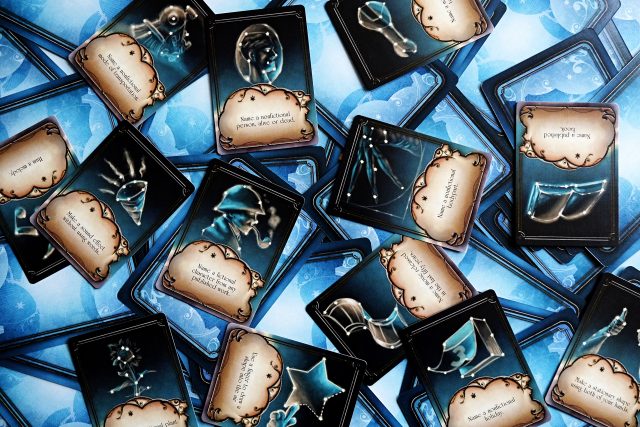In Greek mythology, the muses were goddesses who inspired, who were considered the source of knowledge in works of literature, poetry and even sciences. The name certainly invokes a certain idea, and it’s definitely the spirit behind this game. There are likely comparisons to make when it comes to Muse – two others in particular, due to their clue-giving nature and their gorgeous art: Dixit and Mysterium. What all of these games have in common is the interaction of players with the intricate scenes and art in order to get folks guessing (or not, as the case may be!) what your intentions and clues are. Muse sits somewhere in the middle of these two, for me. It’s not fully competitive or fully cooperative, but mixes them both for fun team play where you’re really trying to put your heads together to trip up the other players.
First things first, the premise of Muse is nice and simple – and so is learning how to play! It boils down to one team selecting a ‘Masterpiece’ (that is, art card) and an ‘Inspiration’ card and then giving those to another team’s “muse” – clue-giver. Following the ‘Inspiration’ card’s direction, the muse gives a clue about the card the other team selected – if the muse’s team manages to guess the correct ‘Masterpiece’ card out of the original 6, they win that point! If not, the team who chose it for them wins. First team to 5 are the victors. The rules are a lovely little double-sided sheet and lay things out really clearly (and there’s a little extra piece for a 2-3 player game too).
 So, the structure and play of this game is really user-friendly, which is great – any party game that you can teach and be playing in just a couple of minutes is a winner! As simple as it is, there’s some very tricky decisions to be made that are influenced by the ‘Inspiration’ cards. Given no restrictions, like Dixit, you could very easily give clues that would make guessing less of a challenge. With the inspiration cards shaping the way clues are given, and what those clues are, you have got to get really creative. You could get “use a finger to draw a shape in the air”, “make a sound effect without using words” or even name a fictional character from any published work” – these are the nuances that, for me, makes things quite interesting. Of course, it can also be pretty variable or feel random, given the spread of the instructions on ‘Inspiration’ cards, but it’s part of the fun and the challenge.
So, the structure and play of this game is really user-friendly, which is great – any party game that you can teach and be playing in just a couple of minutes is a winner! As simple as it is, there’s some very tricky decisions to be made that are influenced by the ‘Inspiration’ cards. Given no restrictions, like Dixit, you could very easily give clues that would make guessing less of a challenge. With the inspiration cards shaping the way clues are given, and what those clues are, you have got to get really creative. You could get “use a finger to draw a shape in the air”, “make a sound effect without using words” or even name a fictional character from any published work” – these are the nuances that, for me, makes things quite interesting. Of course, it can also be pretty variable or feel random, given the spread of the instructions on ‘Inspiration’ cards, but it’s part of the fun and the challenge.
Some aspects of this remind me of bits of Codenames: Pictures in some ways – those images are all really surreal with multiple facets and can be challenging to give clues for, especially when trying to link them together without directing people to the wrong ones. With Codenames, everything is out there on the table throughout the game – in Muse, the muse will only be seeing the ‘Masterpiece’ they will be giving a clue about. So you want to try and get as specific as possible for that card, because once it’s laid out there with the other five, you need it to stand out in relation to the clue! I really love this aspect to the game, because as the team deciding on which ‘Masterpiece’ and which ‘Inspiration’ cards to give the muse, you really get a chance to see what can make a tricky combination – “good luck with them trying to name a fictional character for this card! *evil laugh*” – and you know what will be tougher, given you’ve got the other ‘Masterpiece’ cards to compare to. It’s a really neat balance of actions between teams, and a lot of fun to discuss during your turns.
 Now, you’ve likely seen from the photos accompanying this game that we need to talk about the art on these cards. It’s spectacular. There are 84 of the tarot-sized ‘Masterpiece’ cards, each of them covered in a fully illustrated, rich scene. They’re colourful, fantastical, full of details and just wonderful to look at while playing the game – you might say, an inspiration. Even the 30 ‘Inspiration’ cards look great – each has a little constellation sketch related to the prompt on the card. And even beyond the cards themselves – the rule sheet is a lovely cardstock, with gilt highlights – and even the box has some of that shiny, along with the beautifully illustrated goddess.
Now, you’ve likely seen from the photos accompanying this game that we need to talk about the art on these cards. It’s spectacular. There are 84 of the tarot-sized ‘Masterpiece’ cards, each of them covered in a fully illustrated, rich scene. They’re colourful, fantastical, full of details and just wonderful to look at while playing the game – you might say, an inspiration. Even the 30 ‘Inspiration’ cards look great – each has a little constellation sketch related to the prompt on the card. And even beyond the cards themselves – the rule sheet is a lovely cardstock, with gilt highlights – and even the box has some of that shiny, along with the beautifully illustrated goddess.
I mentioned earlier that Muse can be compared (favourably) to Mysterium or Dixit. They’re all fantastic, good looking games. I love the vibe of Mysterium, and I think it could have a place in a collection along with Muse. As far as Dixit goes, I honestly do think I prefer this game – it’s fun being on teams, and setting up other players with ‘Masterpieces’ and their instructions via ‘Inspiration’ cards. It feels much more lighthearted and much more of a “party” game, to me. Just enough cooperation and competition combined, with easy tracking of scoring and it won’t out-stay its welcome in half an hour. I was delighted by its premise when I first tried it at BGGcon in November of 2017, and it’s held up in plays with other folks since for me. Honestly, flash this box and those cards at a group and who wouldn’t want to give it a try? Inspire them!
—
Muse is a fabulous card game for 2 – 12 players, and plays out in approximately 30 minutes. Published by Quick Simple Fun (thank you for the review copy!), it is designed by Jordan Sorenson, with amazing art by Apolline Etienne, Andre Garcia and Kristen Plescow. It is in stores now!
Comments
No comments yet! Be the first!